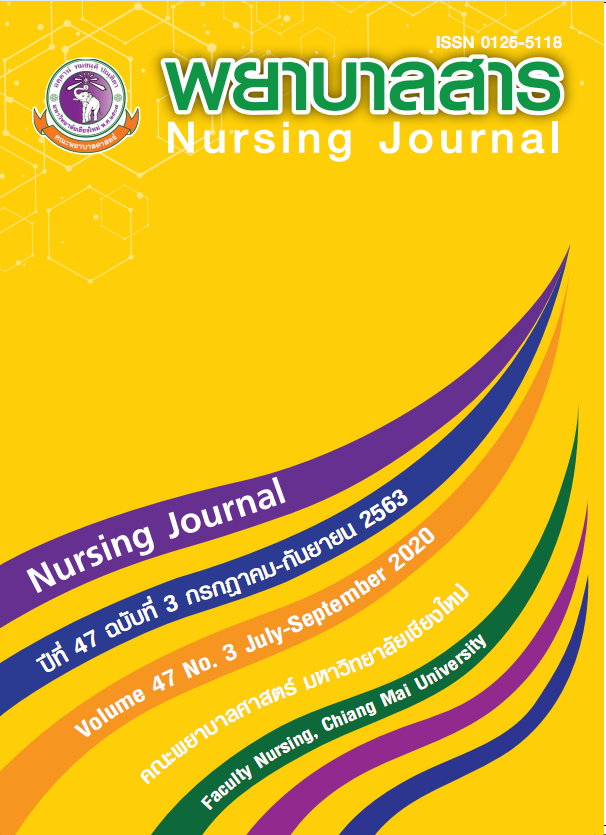Development of Nursing Practice Guidelines for Prevention of Infections in Prisons
Keywords:
Development, Practice Guidelines, Prevention of Infections, Prisons, Registered NurseAbstract
Prison-associated infections can impact the physical and mental health of both prisoners and personnel working in prisons. All prisons have to implement measures for prevention of infections and disease transmission. The aim of this developmental research was to develop a Nursing Practice Guidelines for Prevention of Infections in Prisons using Delphi Technique. The study was conducted from August to December 2016.
The researcher reviewed the guidelines for prevention of infections in prisons of many organizations, and developed draft guidelines that were tested for content validity by 17 infection prevention and control experts, which included physicians, nursing instructors, infection control nurses and registered nurses who had experiences in caring for prisoners. A self-administered questionnaire about the possibilities in applying the developed guidelines was sent by post to 142 registered nurses working in all the prisons in Thailand.
The results of the study revealed that nursing practice guidelines for prevention of infections in prisons consisted of ten main activities including contact precautions, droplet precautions, airborne precautions, hand hygiene, wearing personal protective equipment (PPE), prevention of needlestick and sharp injury (NSI), management of medical instrument and the environment, specimen collection, and linen and infectious waste management. One hundred and six registered nurses responded, with a response rate of 74.6%. For all of the ten main activities, 82.3% of respondents agreed that it was practical to follow the developed guidelines. The activity which respondents agreed was the most practical to practice was prevention of NSI (92.7%) followed by management of linen (85.6%), specimen collection (85.4%), droplet precautions (84.1%), hand hygiene (83.4%), contact and airborne precautions (81.1%), respectively. Less than 80% of respondents agreed that the activities that they could apply were the following: wearing PPE (77.8%), management of medical instrument and environment (77.1%), and infectious waste management (74.2%).
Prisons should promote these practices and support necessary equipment in the prevention of infections for registered nurses so that they can effectively prevent infection and disease transmission in the prisons.
References
Alvarez, Befus, Herzig, & Larson. (2014). Prevalence and Correlates of Hepatitis C virus infection among inmates at two New York State correctional facilities. Journal of Infection and Public Health, 7, 517-521.
Baussano, I., Williams, B. G., Nunn, P., Beggiato, M., Fedeli, U., & Scano, F. (2010). Tuberculosis incidence in prisons: a systematic review. PLoS medicine, 7(12), e1000381.
Bick, J. A. (2007). Infection control in jails and prisons. Clinical Infectious Diseases, 45(8), 1047-1055.
Bureau of Epidemiology (2014). Prevalence of tuberculosis. Retrieved from http://www.hiso.or.th/
Centers for Disease Control and Prevention. (2012). HIV in Correctional Setting. Retrieved From http://www. cdc. gov/hiv
Chatterji, M., Balbwin, A. M., Prakash, R., Vlack, S. A., & Lambert. S. B. (2014). Public Health response to a measles outbreak in a Large Correctional Facility, Queensland, 2013. Communicable Diseases Intelligence Quarterly Report, 38(4), E294-E297.
consideration and applications. Information & Management, 42, 15-29.
Department of Corrections. (2018). National-wide inmates statistics. Retrieved http://www.correct.go.th/stat102/display/select_date_user.php
Green, B., Jones, M., Hughes, D., &Williams, A. (1999). Applying the Delphi technique in a study of GPs’ information requirements. Health & Social Care in the Community, 7(3), 198-205.
Health Protection Agency. (2013). Prevention of infection and communicable disease control in prisons and places of detention. Health Protection Agency and Department of Health, 80-91.
International Centre for Prison Studies. (2014). World Prison Brief. Retrieved From http://www. prisonstudies. org/country/thailand
Irish Prison Service. (2011). Health Care Standard. Retrieved From http://www.irishprisons.ie
Jones, T. F., & Schaffner, W. (2001). Miniature chest radiograph screening for tuberculosis in jails: a cost-effectiveness analysis. American Journal of Respiratory and Critical Care Medicine, 164(1), 77-81. doi: 10.1164/ajrccm.164.1.2010108
Journal of Advanced Nursing, 19, 1221-1225.
Keeney, S., Hasson, F., & McKenna, H. P. (2001). A critical review of the Delphi technique as a research methodology for nursing. International journal of nursing studies, 38(2), 195-200.
Kinsella. (2004). Corrections Health Care Costs. The Council of State Governments. Retrieved From http://www.csg.org.pdf
Konrad, N., Völlm, B., & Weisstub, D. N. (2013). Ethical Issues in Prison Psychiatry. Springer.
Lippincott Williams & Wilkins.
Maruschak, L. M. (2015). HIV in prisons, 2001-2010. AIDS, 20, 25.
McKenna, H. P. (1994). The Delphi technique: A worthwhile research approach for nursing
O'boyle, C., Jackson, M., & Henry, S. J. (2002). Staffing requirements for infection control programs in US health care facilities: Delphi project. American journal of infection control, 30(6), 321-333.
Okoli, C. Pawlowski, S. D. (2004). The Delphi method as a research tool: An example, design
Polit, D. F., Beck, C. T. (2004). Nursing research: Principle and method (7th ed.). Philadelphia:
Simooya, O. O. (2010). Infectious in Prison in Low and Middle Income Countries: Prevalence and Prevention Strategies. The Open Infectious Diseases Journal, 4, 33-37.
Warren, E., Viney, R., Shearer, J., Shanahan, M., Wodak, A., & Dolan, K. (2006). Value for money in drug treatment: economic evaluation of prison methadone. Drug and Alcohol Dependence, 84(2), 160-166.
Webber, A., & Teleclass, T. (2015). Infection Prevention and Control in Correctional Settings. Retrieved From https://webbertraining.com/files/library/docs/621.pdf
Weinbaum, C., Lyerla, R., & Margolis, H. S. (2003). Prevention and control of infections with hepatitis viruses in correctional settings. Massachusetts Medical Society.
Wootton, S. H., Arnold, K., Hill, H. A., McAllister, S., Ray, M., Kellum, M., &, Kuehnert, M. (2004). Intervention to reduce the incidence of Methicillin – resistant Staphylococcus aureus skin infections in a correctional facility in Georgia. Infect Control Hospital Epidemiology, 25(5), 402 – 407.
World Health Organization. (2014). Health in prisons. Retrieved From http://www.euro.who.int/ pub request pdf
Young, L. C., Dwyer, D. E., Harris, M., Guse, Z., Noel, V., & Levy, M. H. (2005). Summer outbreak of respiratory disease in an Australian prison due to an influenza A/Fujian/411/2002 (H3N2)-like virus. Epidemiology & Infection, 133(1), 107-112.
Downloads
Published
How to Cite
Issue
Section
License
บทความที่ได้รับการตีพิมพ์เป็นลิขสิทธิ์ของวารสารพยาบาลสาร
ข้อความที่ปรากฏในบทความแต่ละเรื่องในวารสารวิชาการเล่มนี้เป็นความคิดเห็นส่วนตัวของผู้เขียนแต่ละท่านไม่เกี่ยวข้องกับมหาวิทยาลัยเชียงใหม่ และคณาจารย์ท่านอื่นๆในมหาวิทยาลัยฯ แต่อย่างใด ความรับผิดชอบองค์ประกอบทั้งหมดของบทความแต่ละเรื่องเป็นของผู้เขียนแต่ละท่าน หากมีความผิดพลาดใด ๆ ผู้เขียนแต่ละท่านจะรับผิดชอบบทความของตนเองแต่ผู้เดียว






